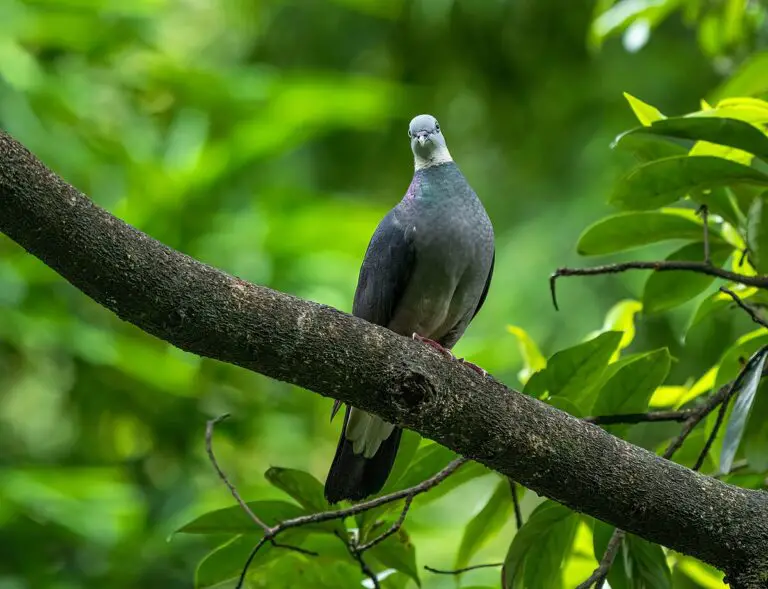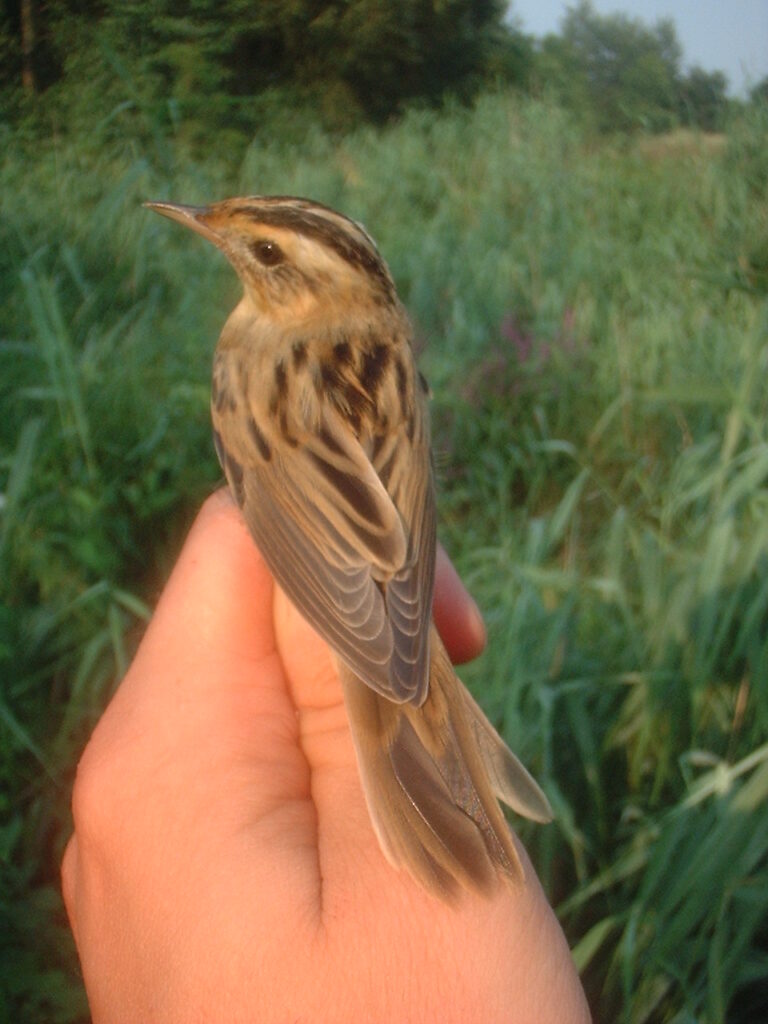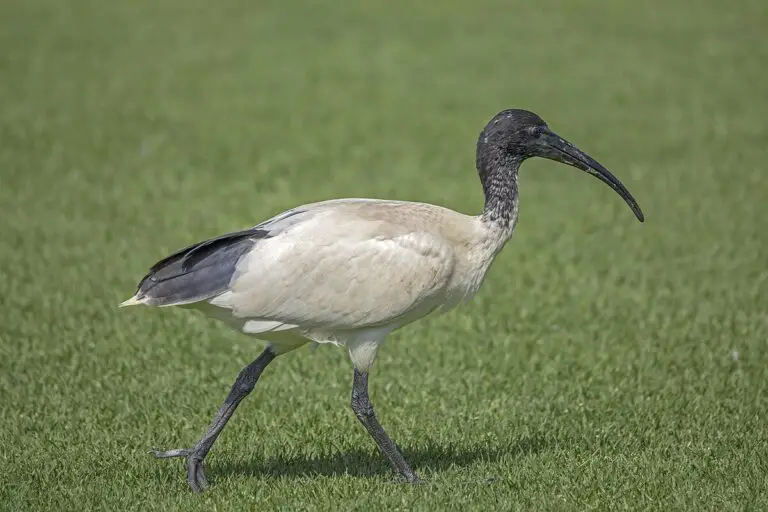Eurasian Jay (Garrulus glandarius)
“The Eurasian jay has the ability to mimic other sounds.”
The Eurasian Jay belongs to the following scientific classification:
- Kingdom: Animalia
- Phylum: Chordata
- Class: Aves
- Order: Passeriformes
- Family: Corvidae
- Genus: Garrulus
- Species: Garrulus glandarius
Conservation Status: Least Concern
Locations: The Eurasian Jay can be found in Africa, Asia, Eurasia, and Europe.
This classification places the Eurasian Jay within the broader context of the animal kingdom, specifying its taxonomic relationships and characteristics within the bird class Aves and the family Corvidae, which includes crows, ravens, and magpies among other species.
Here are some detailed facts about the Eurasian Jay:
Common Name: Eurasian Jay
Scientific Name: Garrulus glandarius
Number of Species: 1
Location: Eurasia and North Africa
Habitat: Mixed forests and grasslands
Prey: The Eurasian Jay feeds on fruits, grains, nuts, snails, slugs, worms, insects, and occasionally other birds.
Diet: Omnivore
Predators: Predators of the Eurasian Jay include cats, martens, owls, crows, eagles, and others.
Biggest Threat: Habitat loss
Fun Fact: The Eurasian Jay has the ability to mimic other sounds.
Most Distinctive Feature: Bright blue wing feathers
Other Name(s): Common jay
Type: Bird
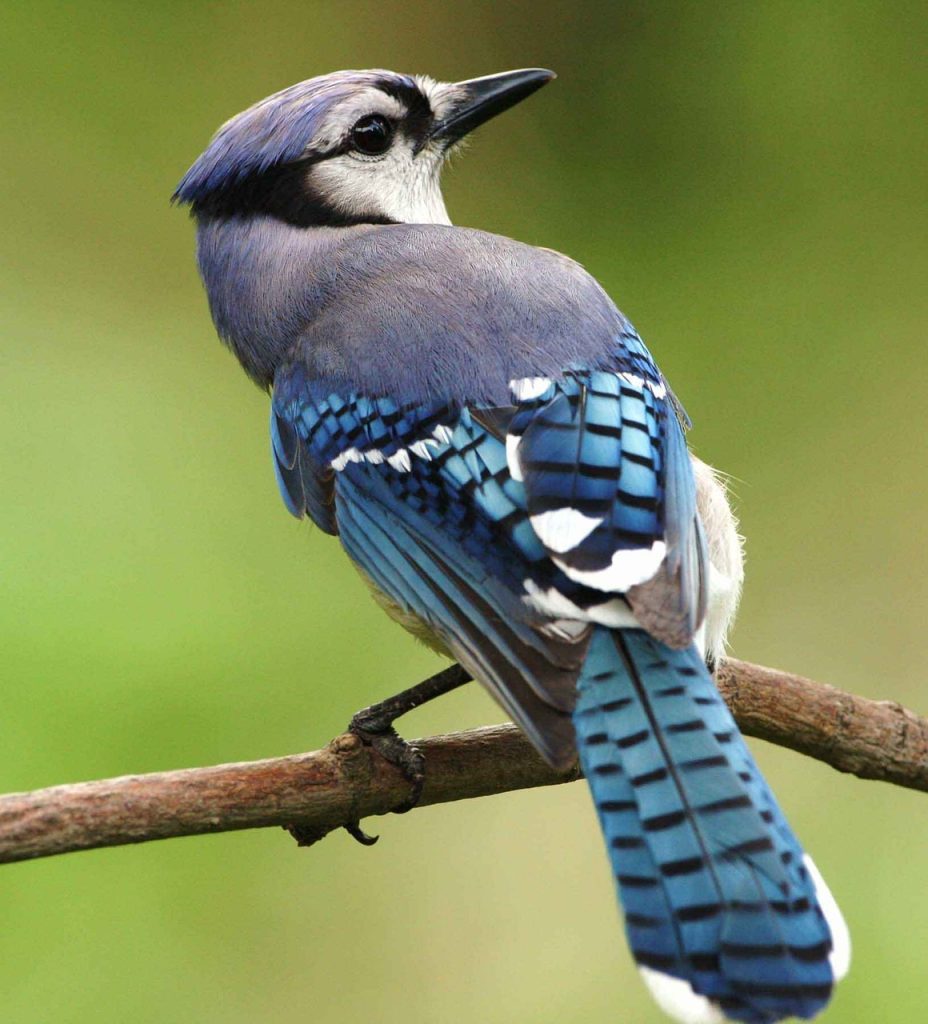
Physical Characteristics:
- Color: Brown, blue, black, white
- Skin Type: Feathers
- Top Speed: 20 mph
- Weight: 170g (6oz)
- Height: 34-35cm (13-14in)
- Wingspan: 52-58cm (20-23in)
Incubation Period: 18 days
Nesting Location: Trees and bushes
Age of Molting: 20-23 days
Estimated Population Size: 30-65 million mature individuals
The Eurasian Jay is a versatile bird found across a wide geographic range, characterized by its striking blue wing feathers and its adaptability to varied habitats and diets.
3 Eurasian Jay Amazing Facts
- Eurasian jays have a unique way of keeping their feathers free from parasites. They cover themselves in ants, which release formic acid. This acid helps to eliminate any unwanted pests. This behavior is known as anting.
- A single Eurasian jay can bury an impressive number of acorns each year — between 4,500 and 11,000. What’s even more remarkable is that they can remember where they’ve hidden these acorns for up to 10 months.
- The wings of Eurasian jays possess a special ability to reflect ultraviolet light, which is invisible to humans. This feature seems to be crucial in their mating rituals, although the exact reasons are still being studied.
Where to Find the Eurasian Jay
The Eurasian jay is typically found in regions across temperate Europe, Asia, and northern Africa where there is abundant dense foliage and tree cover. Unlike migratory birds, they tend to stay within their preferred habitats year-round as long as there is sufficient food available.
They thrive in areas rich with deciduous trees and oak forests, which offer ample opportunities for foraging. When it comes to nesting, they favor coniferous trees, which provide secure and suitable sites for breeding and raising their young.
Among their favored tree species are English oaks, cork oaks, sessile oaks, and Portuguese oaks, which provide both nesting locations and a dependable food source. These environments support the Eurasian jay’s lifestyle and contribute to its presence across their extensive range.
The Eurasian jay builds its nest in the form of a small cup-shaped structure. It is crafted using a combination of materials such as sticks, roots, hairs, and feathers. These nests are typically situated in bushes or trees, providing a secure and elevated location for breeding and raising their offspring. This nesting behavior aligns with their preference for dense foliage and tree cover, where they can protect and nurture their young effectively.

Scientific Name
The Eurasian jay goes by the scientific name Garrulus glandarius. The genus name, Garrulus, originates from the Latin word meaning chatty, noisy, or babbling, reflecting the bird’s vocal tendencies. The species name, glandarius, is derived from another Latin word meaning acorn or nut, highlighting its behavior of storing and consuming acorns.
This bird is closely related to the black-headed jay found in central Asia and Lidth’s jay from Japan. Across its range, there are several recognized subspecies of the Eurasian jay, each displaying slight variations in plumage colors and geographic distribution. These subspecies contribute to the diverse characteristics observed within the species as a whole.
Evolution
Eurasian jays, classified within the genus Garrulus, share a close relationship with other jays such as the black-headed jay and Lidth’s jay. They belong to the expansive Corvidae family, which includes surprising relatives like crows, jackdaws, and ravens.
This family, comprising 135 species, also encompasses choughs, magpies, nutcrackers, and treepies. Its evolutionary history stretches back to the Miocene epoch, spanning from 5.33 to 23.03 million years ago. During the Middle Miocene, early genera like Miocorvus appeared, believed to be ancestral to modern crows, jays, and magpies.
The genus Garrulus is thought to have originated in southwestern France, with related genera such as Miopica found in Ukraine sharing similar classification. This lineage provides insights into the diverse and ancient origins of the Corvidae family, showcasing its evolution and distribution over millions of years.
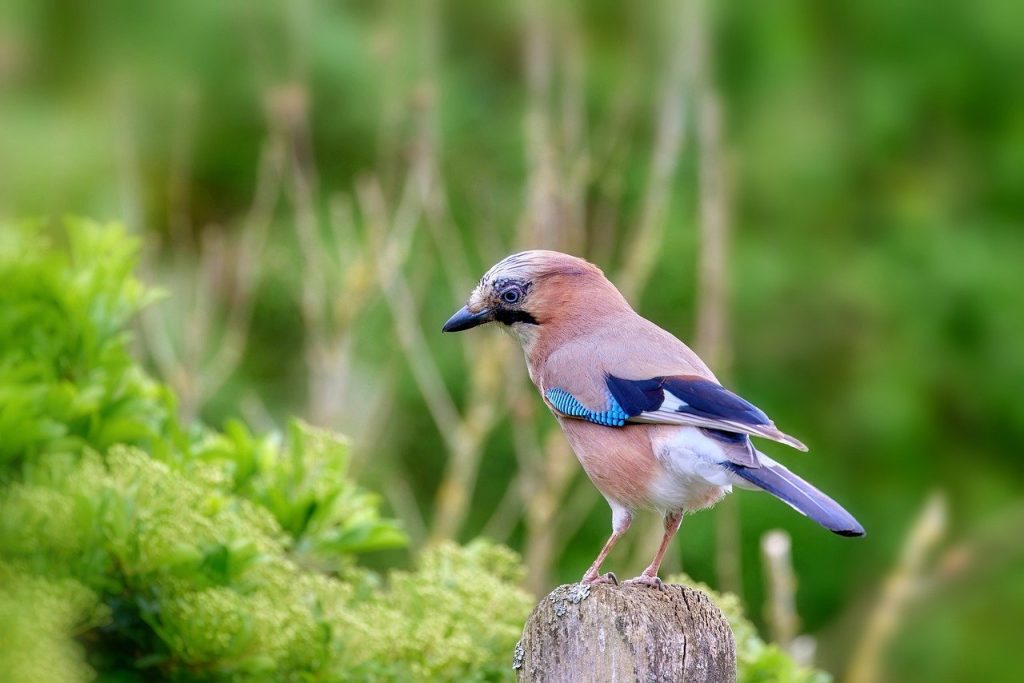
Size, Appearance, and Behavior
The Eurasian jay, despite being relatively small compared to other members of the Corvid family, stands about 13 inches tall and spans nearly 2 feet from wingtip to wingtip when fully extended. Its body is adorned with reddish-brown feathers featuring bright blue spots and black speckles along the wings, visible white bands during flight, and a prominent crest on its head marked with white and black speckles. Both males and females share similar appearances, with females generally being slightly larger.
Communication among Eurasian jays is diverse and expressive. They use a variety of positions, movements, and calls to convey different messages. For instance, they may extend their wings outward to signal submissive behavior, perform frantic movements and emit screeches when alarmed or threatened, and utilize specific vocalizations and displays to express emotions like anger, playfulness, and desire. Like many Corvids, they are adept mimics, incorporating sounds they hear in their environment into their repertoire. This mimicry can serve to express emotions associated with those sounds, such as using harsher sounds when feeling threatened.
During much of the year, Eurasian jays gather in large groups with fluid social hierarchies. Typically, males hold dominance over females, though this can vary, such as when males are molting. Dominance disputes are occasionally settled through physical confrontations.
While they generally remain in the same area throughout the year, Eurasian jays may undertake short migrations in response to food scarcity, demonstrating a flexible adaptation to changing environmental conditions.
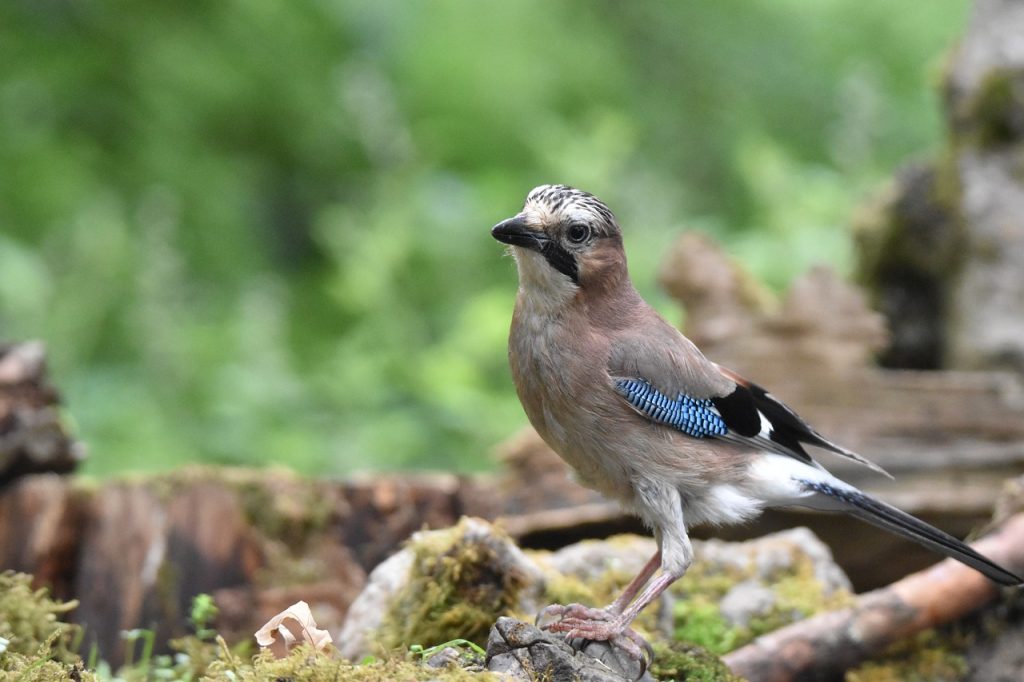
Diet
The Eurasian jay is renowned for its adaptability as an opportunistic omnivore, consuming a wide variety of food sources it encounters. Throughout the day, these birds actively fly through trees, where they primarily forage, although they also venture to the ground on occasion.
Their diet consists of fruits, grains, nuts, snails, slugs, worms, and various insects. However, their preference and notable skill lie in acquiring and processing acorns, which they favor above all else. Using their beaks as efficient tools, jays expertly crack open acorn shells to access the nutritious kernels inside. During the fall, they diligently collect fresh, high-quality acorns, burying them strategically for future use throughout the year. They carry acorns in their bills and also store them in their crop, an organ located near the esophagus that aids in temporary food storage.
While acorns are their primary food source, Eurasian jays are opportunistic enough to also consider small birds, eggs, and even carrion as potential meals, showcasing their versatility in scavenging and hunting behaviors.
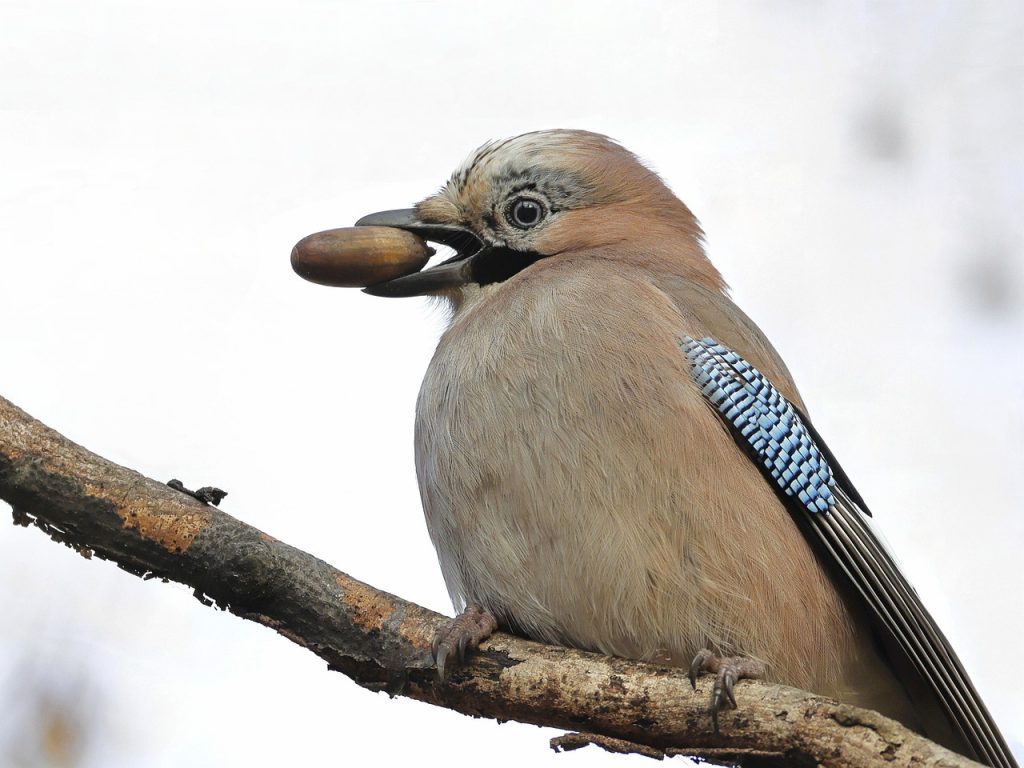
Predators, Threats, and Conservation Status
The Eurasian jay, classified as a species of least concern by the IUCN Red List, is generally not under significant threat at present. However, its reliance on tree and brush cover makes it susceptible to habitat loss and fragmentation.
In terms of predators, Eurasian jays face threats from a variety of animals including martens, cats, eagles, owls, crows, kestrels, and other birds of prey. When confronted by a predator, Eurasian jays exhibit a defensive behavior known as mobbing, where a group of jays will gather and aggressively confront the predator to drive it away. This behavior can include vocalizations, aggressive flights, and even mimicry of other bird species’ alarm calls, which may confuse or intimidate the predator.
To mitigate the risk of predation, Eurasian jays tend to avoid open spaces where predators are more likely to spot them, preferring the cover and safety provided by trees and dense vegetation. This strategy helps them to navigate their environment safely while balancing their foraging and nesting activities.
Reproduction, Young, and Molting
Eurasian jays engage in their mating rituals once a year, typically between March and June. During this time, when they gather in groups, these birds perform elaborate courtship displays to attract mates. Males are particularly active in displaying their prowess; they chase females in intricate aerial maneuvers and often present them with food as part of their courtship behavior.
After successfully mating, the female Eurasian jay will lay a single clutch of eggs, typically containing four to five eggs, in the nest. Both parents take turns to incubate the eggs, a process that lasts approximately 18 days until the chicks hatch. At birth, the chicks are nearly naked and blind, entirely dependent on their parents for care and nourishment.
As the chicks grow, they begin to fledge around 20 days after hatching, meaning they start to develop feathers and prepare for flight. Despite this milestone, they remain reliant on their parents for at least another two months as they learn essential survival skills. It takes approximately two years for Eurasian jays to reach full sexual maturity.
In the wild, Eurasian jays face challenges from diseases and predators, which limit their average lifespan to just a few years. However, under optimal conditions, they can live longer; the oldest recorded Eurasian jay lived nearly 17 years. These factors highlight the precarious balance of survival and reproduction in their natural environment.

Population
According to the estimates by the IUCN (International Union for Conservation of Nature), the population of Eurasian jays in the wild is robust, with between 30 million to 65 million mature individuals. These numbers indicate that the species is widespread and its population is considered stable at present.
This stability suggests that Eurasian jays are not facing immediate threats that would significantly impact their overall numbers. However, as with many species, ongoing monitoring and conservation efforts are crucial to ensure that their habitats remain intact and their populations continue to thrive in the face of potential future challenges such as habitat loss and environmental changes.
Conclusion
The Eurasian jay (Garrulus glandarius) stands out as a resilient and adaptable member of the Corvidae family. With its striking plumage, versatile diet, and complex social behaviors, including elaborate courtship rituals and cooperative breeding, the Eurasian jay thrives across its extensive range in temperate Europe, Asia, and northern Africa. Although susceptible to habitat loss, current estimates indicate a stable and widespread population of 30 million to 65 million mature individuals in the wild. This species exemplifies the dynamic interplay between natural adaptation and human impact, underscoring the importance of conservation efforts to safeguard its habitats and ensure its continued presence in ecosystems.

